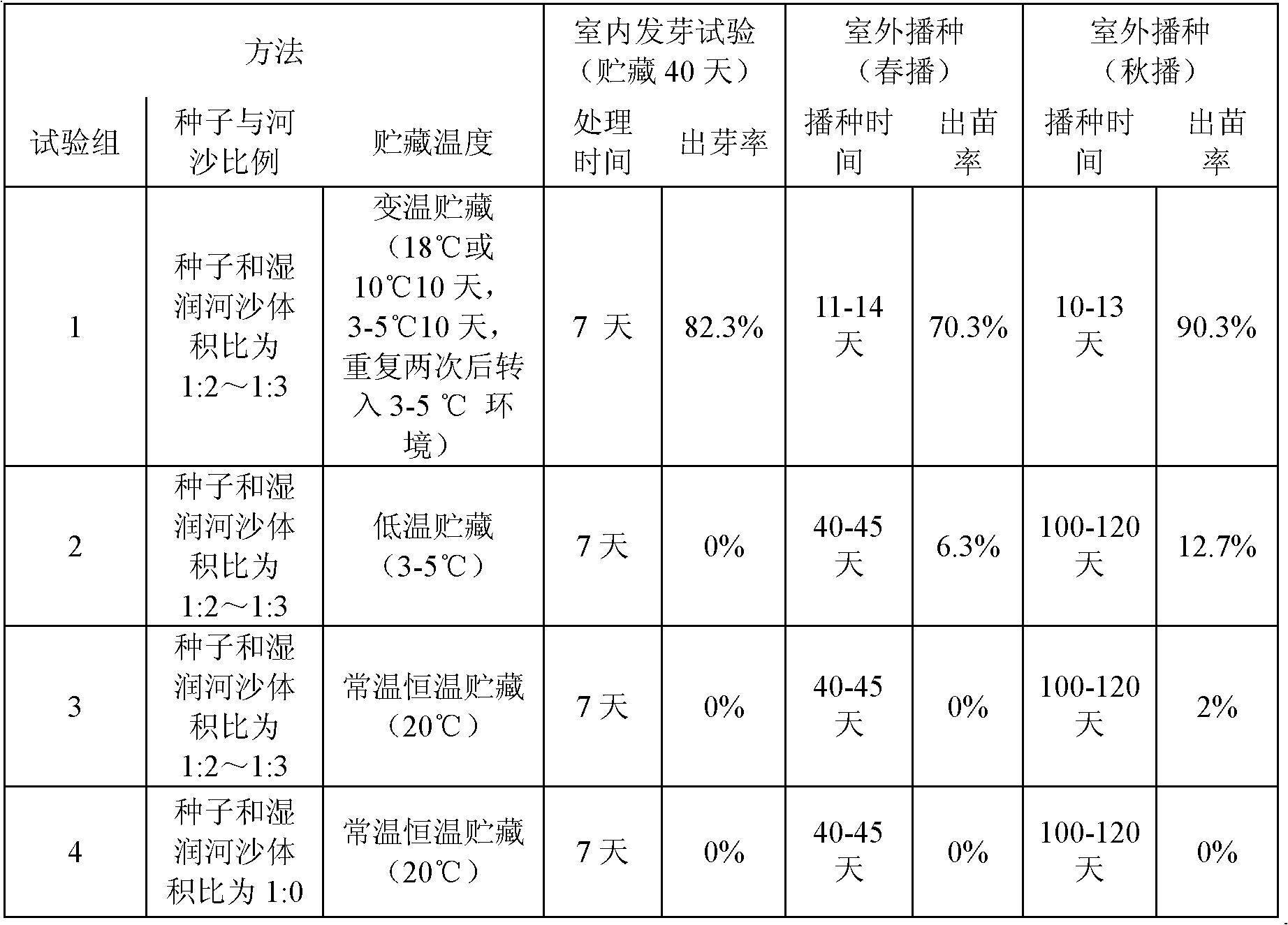Method for raising seedlings of redrlowered loropetalum
A technology of safflower and seeds is applied in the field of plant seedling raising, which can solve the problems of long cultivation time and low seedling emergence rate, and achieve the effects of improving the seedling emergence rate and shortening the germination time.
- Summary
- Abstract
- Description
- Claims
- Application Information
AI Technical Summary
Problems solved by technology
Method used
Image
Examples
Embodiment 1
[0019] Harvest the mature safflower fruit in the first ten days of October, dry in the shade for 2 to 3 days, and then thresh, collect the seeds for later use; mix the threshed seeds with wet river sand at a volume ratio of 1:3, and put them into self-sealing plastic bags for later use ; Store the bagged seeds at 18°C for 10 days, then store the seeds at 3-5°C for 10 days, repeat the previous storage steps twice, and then transfer the seeds to an ambient temperature of 3-5°C for storage , keep the sand moist throughout the storage period; after 40 days, the seeds will break open one after another, take out the seeds and spread them, cover them with thin soil after sowing, and then cover them with dead grass (broken grass trimmed from lawn grass) to prevent water from washing away the seeds And play the role of heat preservation, pour water thoroughly after sowing, adjust the temperature and light intensity by covering with plastic film and sunshade net according to the weathe...
Embodiment 2
[0021] Harvest the mature safflower fruit in the first ten days of October, dry in the shade for 2 to 3 days, and then thresh, collect the seeds for later use; mix the threshed seeds with moist river sand at a volume ratio of 1:2, and put them into self-sealing plastic bags for later use ;Store the bagged seeds at 10°C for 10 days, then store the seeds at 3-5°C for 10 days, repeat the previous storage steps twice, and then transfer the seeds to an ambient temperature of 3-5°C for storage , keep the sand moist throughout the storage period; after 40 days, the seeds will break open one after another, take out the seeds and spread them, cover them with thin soil after sowing, and then cover them with dead grass (broken grass trimmed from lawn grass) to prevent water from washing away the seeds And play the role of heat preservation, pour water thoroughly after sowing, adjust the temperature and light intensity by covering with plastic film and sunshade net according to the weather...
Embodiment 3
[0022] Embodiment 3 Seedling raising method of the present invention and the seedling raising effect contrast test of prior art
[0023] Seedling raising method of the present invention and the seedling raising effect contrast test of prior art and effect are as shown in table 1:
[0024] Test group 1 adopts the seedling raising method of the present invention; Test group 2 to 4 adopts the seedling raising method of the prior art, as contrast; The seeds that get in all test groups are the same batch of samples of Safflower seeds.
[0025] Table 1
[0026]
[0027] As can be seen from Table 1, when sowing with seeds that are not stored in sand or processed with common normal temperature and constant temperature sand storage methods, the ratio of seed germination and emergence is low (less than 15%), and the time required is long, and autumn sowing requires The time is about 100-120 days, and the spring sowing takes about 40-45 days. And can greatly shorten seed germination...
PUM
 Login to View More
Login to View More Abstract
Description
Claims
Application Information
 Login to View More
Login to View More - R&D
- Intellectual Property
- Life Sciences
- Materials
- Tech Scout
- Unparalleled Data Quality
- Higher Quality Content
- 60% Fewer Hallucinations
Browse by: Latest US Patents, China's latest patents, Technical Efficacy Thesaurus, Application Domain, Technology Topic, Popular Technical Reports.
© 2025 PatSnap. All rights reserved.Legal|Privacy policy|Modern Slavery Act Transparency Statement|Sitemap|About US| Contact US: help@patsnap.com

